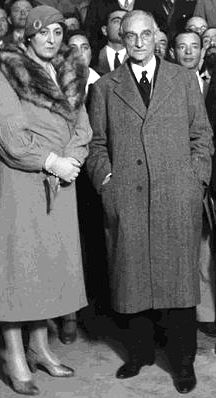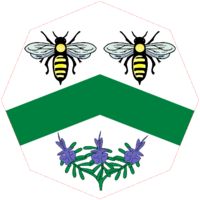Stella Isaacs, Marchioness of Reading facts for kids
Quick facts for kids
The Most Honourable
The Marchioness of Reading
|
|
|---|---|

Stella Isaacs, Marchioness of Reading in a WVS wartime poster
|
|
| Member of the House of Lords Lord Temporal |
|
| In office 22 September 1958 – 22 May 1971 Life Peerage |
|
| Personal details | |
| Born |
Grace Stella Charnaud
6 January 1894 |
| Died | 22 May 1971 (aged 77) |
| Spouse | |
Stella Isaacs, also known as the Marchioness of Reading and Baroness Swanborough, was a very important English helper and leader. She was born Stella Charnaud on January 6, 1894, and passed away on May 22, 1971. She is best known for starting and leading the Women's Voluntary Service (WVS), which is now called the Royal Voluntary Service.
As Lady Reading, she worked hard to improve the friendship between Britain and the United States. She was the wife of a former British Ambassador to the US. After the war, she helped Britain's economy grow and found good jobs for women, both paid and volunteer. Besides the WVS, she also created Women's Home Industries. This group was great at showing off British crafts like clothing and textiles. They also sold many items to the United States and Canada.
She was part of many important groups, like the BBC Advisory Board. She also strongly supported the start of the University of Sussex. In 1958, she made history by becoming the first woman to join the House of Lords on her own. Someone once said that if she had been a man, she would have become Prime Minister!
Contents
Early Life and Education
Stella Charnaud was born on January 6, 1894, in Constantinople, which is now called Istanbul. Her father, Charles Charnaud, worked for a tobacco company. Her mother, Milbah Johnson, was from England. Stella's family lived in a place called Moda, on the Asian side of the Bosphorus strait.
Because she often felt unwell, Stella learned mostly from private teachers at home. She was the fifth of nine children. She spent many months in bed due to back problems. But she later said this helped her become a good listener for her brothers and sisters. She learned to speak French and German very well, and some Italian and Greek too.
During World War I, Stella worked for the British Red Cross Society. This gave her useful experience for her future work. However, she was once moved to a different job because she would faint when she saw blood!
After the war, her family lost money, so Stella needed to find a job. She first worked in a lawyer's office. In 1914, the year the war began, she started training to be a secretary in London.
Working in India and Marriage
In 1925, Stella was asked to work for the Viceroy in Delhi, India. The Viceroy was the ruler of India at that time. She first worked as a secretary for the Viceroy's wife, Lady Reading. Soon, she became the Viceroy's chief of staff. Later, she worked as his private secretary at a company called Imperial Chemical Industries.
After the Viceroy's wife passed away in 1930, Stella became his political hostess. This meant she helped him entertain important guests. Stella and Rufus Isaacs, the Viceroy, got married on August 6, 1931. He was 71, and she was 37. Everyone thought this was a wonderful match. From then on, she was known as the Marchioness of Reading, or Lady Reading. Even though it was a big change to go from secretary to the wife of a very important man, she handled it easily. In 1932, she became the head of the Personal Service League. This group helped people who were poor during the Great Depression.
Building Bridges with America
Lady Reading's marriage was short, as Lord Reading passed away in 1935. But he had a big impact on her life. He told her that after he was gone, she would want to "serve the country." He also taught her how important the friendship between the United States and the UK was. He believed that the future of democracy depended on British people understanding Americans better.
After her husband's death, she felt lost for a while. She traveled to the United States by car, staying in cheap places and even washing dishes. She wanted to understand "ordinary" Americans. Her trip ended when a police officer stopped her and said, "The President wants you to call him." She returned to Washington D.C. and became a close friend of Eleanor Roosevelt, the First Lady. They both cared about helping poor people and wrote to each other often.
Early Volunteer Work
Even before her husband died, Lady Reading was active in volunteer work. She led the Personal Service League, which helped people in need. In 1935, she was the only woman on the Ullswater Commission, which looked at broadcasting. Later, she joined the BBC Advisory Council.
Women's Voluntary Service
In 1938, a year before World War II began, the government asked Lady Reading to create a group of women to help if war broke out. Lady Reading started the Women's Voluntary Service for Air Raid Precautions Services. It was later simply called the Women's Voluntary Service, or WVS. She designed how the group would work.
The WVS recruited women from all over the country. By 1942, one million women had joined! The idea was to get women from all backgrounds and avoid too many rules. Women wore uniforms, but they were encouraged to use their own ideas. Their duties were many, from helping soldiers and refugees to moving children and pregnant women out of cities that might be bombed.
At first, the WVS offered many training courses. These included driving in the blackout and childcare. They even taught people how to train others. In London, courses were taught in many languages for foreign people in the WVS. On August 31, 1939, when war was certain, people were told to leave cities right away. Lady Reading's WVS helped move 1.5 million people in just three days.
As the war went on, the WVS helped feed, clothe, and re-house people affected by air raids. The government and local groups paid for their work.
The WVS continued after the war. Right after the war, they helped with problems like food, fuel, and housing shortages. In 1963, they still had about 1,200 centers across the country. It remained a volunteer group and became a key part of civil defense and social welfare.
Women's Home Industries
After the war, Lady Reading started another project to help the country and women. Women's Home Industries began in 1947. Its goal was to encourage women's crafts and earn money for Britain. The WVS collected samples from its members, like tapestry, embroidery, quilting, and hand knitting. This led to a new business supported by the government.
The company stayed connected to the WVS at first. Lady Reading was the head of both the company and the WVS. In the 1950s, it became a separate company. It was very successful at selling professionally made clothing and crafts, especially to the United States. Most of the people making these items were women working from home.
House of Lords
On September 22, 1958, Lady Reading was given a special title called a life baroness. This meant she could join the House of Lords for the rest of her life. She was one of the first four women to receive this honor. She chose the title Baroness Swanborough. She sat as an independent member, not belonging to any political party. Her husband had been a Liberal minister, but now she could follow her own path.
When she joined, she was the first woman peer to sit in the House of Lords. In her first speech, she asked the government about its plans for refugees and people who had lost their homes. She had experience helping them during the war. She praised the work of volunteer groups. She also asked the government to support the UNHCR around the world. She cared a lot about children who had no country and could not become citizens.
She also led a group for the Home Office from 1962 to 1965. This group helped people from the Commonwealth, known as the "Windrush" migrants, come to Britain. In 1965, she was asked to work on how volunteer groups could help prisoners after they were released. She talked about the prison system and the rights of prisoners. She also discussed how they could be cared for and what their rights and duties should be.
Other Important Roles
From 1936 to 1968, Lady Reading was a vice-chair of the Imperial Relations Trust. She was also a member of the BBC Advisory Board and its vice-chair from 1947 to 1951. She led a group for the Home Office that looked at immigration from the Commonwealth. She also led a group that helped prisoners after they left jail.
She was an early supporter of the University of Sussex, which started in 1961. She left her home, Swanborough Manor, to the university to be used by its leader for 50 years after her death. The university later sold the manor in 2003. She was also a trustee for the Glyndebourne opera house.
Awards and Recognition
Lady Reading received many honors for her work. She was made a Dame Commander of the Order of the British Empire (DBE) in 1941. Then, she was promoted to Dame Grand Cross (GBE) in 1944. On September 22, 1958, she became Baroness Swanborough, a life peer in her own right. She was the first woman to take her seat in the House of Lords.
She also received special degrees from several universities. These included the University of Reading (1947), Yale (1958), Manitoba (1960), Smith College (1956), and the University of Leeds (1969).
Arms
|
External Links
- Oxford Dictionary of National Biography entry
- Royal Voluntary Service home page
- National Portrait Gallery portraits





